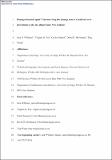| dc.contributor.author | Williams, Jack N. | |
| dc.contributor.author | Toy, Virginia G. | |
| dc.contributor.author | Massiot, Cécile | |
| dc.contributor.author | McNamara, David D. | |
| dc.contributor.author | Wang, Ting | |
| dc.date.accessioned | 2017-08-15T08:10:00Z | |
| dc.date.issued | 2016-07-25 | |
| dc.identifier.citation | Williams, Jack N., Toy, Virginia G., Massiot, Cécile, McNamara, David D., & Wang, Ting. (2016). Damaged beyond repair? Characterising the damage zone of a fault late in its interseismic cycle, the Alpine Fault, New Zealand. Journal of Structural Geology, 90, 76-94. doi: http://dx.doi.org/10.1016/j.jsg.2016.07.006 | en_IE |
| dc.identifier.issn | 1873-1201 | |
| dc.identifier.uri | http://hdl.handle.net/10379/6729 | |
| dc.description.abstract | X-ray computed tomography (CT) scans of drill-core, recovered from the first phase of the Deep Fault Drilling Project (DFDP-1) through New Zealand's Alpine Fault, provide an excellent opportunity to study the damage zone of a plate-bounding continental scale fault, late in its interseismic cycle. Documentation of the intermediate-macro scale damage zone structures observed in the CT images show that there is no increase in the density of these structures towards the fault's principal slip zones (PSZs), at least within the interval sampled, which is 30 m above and below the PSZs. This is in agreement with independent analysis using borehole televiewer data. Instead, we conclude the density of damage zone structures to correspond to lithology. We find that 72% of fractures are fully healed, by a combination of clays, calcite and quartz, with an additional 24% partially healed. This fracture healing is consistent with the Alpine Fault's late interseismic state, and the fact that the interval of damage zone sampled coincides with an alteration zone, an interval of extensive fluid-rock interaction. These fractures do not impose a reduction of P-wave velocity, as measured by wireline methods. Outside the alteration zone there is indirect evidence of less extensive fracture healing. | en_IE |
| dc.description.sponsorship | DFDP-1 was funded by: GNS Science; Victoria University of Wellington; the University of Otago; the University of Auckland; the University of Canterbury; Deutsche Forschungsgemeinschaft and the University of Bremen; Natural Environment Research Council grants NE/J024449/1, NE/G524160/1 and NE/H012486/1 and the University Of Liverpool; and the Marsden Fund of the Royal Society of New Zealand. | en_IE |
| dc.format | application/pdf | en_IE |
| dc.language.iso | en | en_IE |
| dc.publisher | Elsevier | en_IE |
| dc.relation.ispartof | Journal Of Structural Geology | en |
| dc.rights | Attribution-NonCommercial-NoDerivs 3.0 Ireland | |
| dc.rights.uri | https://creativecommons.org/licenses/by-nc-nd/3.0/ie/ | |
| dc.subject | Damage zone | en_IE |
| dc.subject | Alpine fault | en_IE |
| dc.subject | Fault-healing | en_IE |
| dc.subject | DFDP | en_IE |
| dc.subject | Fracture density | en_IE |
| dc.title | Damaged beyond repair? Characterising the damage zone of a fault late in its interseismic cycle, the Alpine Fault, New Zealand | en_IE |
| dc.type | Article | en_IE |
| dc.date.updated | 2017-07-24T10:43:58Z | |
| dc.identifier.doi | 10.1016/j.jsg.2016.07.006 | |
| dc.local.publishedsource | https://doi.org/10.1016/j.jsg.2016.07.006 | en_IE |
| dc.description.peer-reviewed | peer-reviewed | |
| dc.contributor.funder | |~| | |
| dc.description.embargo | 2018-07-25 | |
| dc.internal.rssid | 11991945 | |
| dc.local.contact | David Mcnamara, -. - Email: david.d.mcnamara@nuigalway.ie | |
| dc.local.copyrightchecked | Yes | |
| dc.local.version | ACCEPTED | |
| nui.item.downloads | 517 | |


